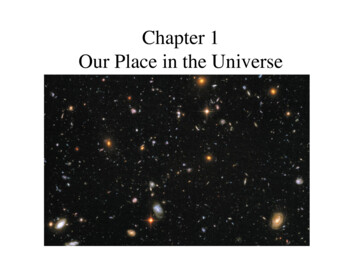
Transcription
Chapter 1 Our Place in the Universe
Messages Survey of Astronomical Objects– What will we learn in AST 101? Scales of the objects– How big/many are they? Motions of the objects– They are MOVING in the sky!
Introduction of Astronomical Objects1.1 A Modern View of the UniverseOur goals for learning: What is our place in the universe? How did we come to be? How can we know what the universe was like in thepast? Can we see the entire universe?
What is our place in the universe?What kind of astronomical objects doyou know?
Examples of Astronomical Objects Star Planet Satellite (e.g., Moon) Asteroid CometSolar systemWhichNebularStellar clusterWhichGalaxyCluster of galaxiesLarge scale structureUniverseobject is the largest?object is the smallest?
StarA large, glowing ball of gas that generates heatand light through nuclear fusionWhy do stars have different colors?
PlanetMarsNeptuneA moderately large object that orbits a star; itshines by reflected light. Planets may be rocky,icy, or gaseous in composition.Take AST105 to learn about planetsEarth diameter 12,700 km
Pluto is not a planet anymorePluto diameter 2300kmWith modern telescopes, we are finding too many Pluto-size objects.
Moon (or satellite)Is the earth the only planet that has a satellite?An object that orbitsa planet.From Galileo spacecraftMoon diameter 3500 kmTitan
AsteroidA relatively smalland rocky objectthat orbits a star.Non-spherical shapeà Self-gravity not importantIdaFor comparison: What is the size of the SBU campus? 2.5 miles 4 km
CometA relativelysmall and icyobject thatorbits a star.
Solar (Star) SystemA star andall thematerial thatorbits it,including itsplanets andmoonsHow many stars in the solar system?
Orion constellationDust observedin infrared lightNebulaAn interstellarcloud of gas and/or dustNGC3603
GalaxyA great island of stars in space, all held togetherby gravity and orbiting a common centerNGC 1300M51Arp 274 100 billion stars
Galaxy and Solar SystemGalaxy ( 100 billion stars)Solar system(only 1 star Sun)
Cluster of GalaxiesAbel 1689Stephan’s QuintetGroup of galaxies 10 galaxiesCluster of galaxies 100-1000 galaxies
Large Scale StructureFilaments and voids ingalaxy distributionin the UniverseFrom Sloan Digital Sky Survey
UniverseThe sum total ofall matter andenergy; that is,everythingwithin andbetween allgalaxies 14 billion years old
How did we come to be?UniverseGalaxyBig BangPlanetStar and Nebula
How can we know that the universe waslike in the past? Light travels at a finite speed (300,000 km/s).DestinationLight travel timeMoon1 secondSun8 minutesSirius8 yearsAndromeda Galaxy2.5 million years Thus, we see objects as they were in the past:The farther away we look in distance, the further back we look in time.
Example 1:We see theOrion Nebula asit looked 1,500years ago.M31, The Great Galaxyin Andromeda
Example 2:This photo shows the Andromeda Galaxy as it looked about2 1/2 million years ago.Question: When will be able to see what it looks like now?M31, The Great Galaxyin Andromeda
Light-year The distance light can travel in one year. About 10 trillion km (6 trillion miles).Unit of distance, not time!
At great distances, we see objects as they were when the universe was much younger.
How far is a light-year?1 light - year (speed of light) (1 year)#km & # 365 days 24 hr 60 min 60 s & % 300,000 ( % ( s ' 1 yr1 day1 hr1 min '
How far is a light-year?1 light - year (speed of light) (1 year)#km & # 365 days 24 hr 60 min 60 s & % 300,000 ( %( s ' 1 yr1 day1 hr1 min ' 9,460,000,000,000 kmAbout 9 trillion kilometers!!
Can we see the entire universe?
Thought Question Why can’t we see a galaxy 15 billion light-years away? (Assume universe is 14 billion years old.)A. Because no galaxies exist at such a great distance.B. Galaxies may exist at that distance, but their lightwould be too faint for our telescopes to see.C. Because looking 15 billion light-years away meanslooking to a time before the universe existed.
What have we learned? What is our physical place in the universe?– Earth is part of the Solar System, which is inthe Milky Way galaxy, which is a member ofthe Local Group of galaxies in the LocalSupercluster How did we come to be?– The matter in our bodies came from the BigBang, which produced hydrogen and helium– All other elements were constructed from Hand He in star and then recycled into new starsystems, including our solar system
What have we learned? How can we know that the universe waslike in the past?– When we look to great distances we areseeing events that happened long ago becauselight travels at a finite speed Can we see the entire universe?– No, the observable portion of the universe isabout 14 billion light-years in radius becausethe universe is about 14 billion years old
1.2 The Scale of the UniverseOur goals for learning: How big is Earth compared to our solar system?How far away are the stars?How big is the Milky Way Galaxy?How big is the universe?How do our lifetimes compare to the age of theuniverse?Scale of the Universe in Space and Time
How much is this house?A. 1,000,000B. 2,000,000C. 4,000,000Press “A”, “B”, or “C”
How big is Earth compared to our solarsystem? Let’s reduce the size of the solar system by a factor of10 billion; the Sun is now the size of a large grapefruit(14 cm diameter). How big is Earth on this scale?A. an atomB. a ball pointC. a marbleD. a golf ball
The scale of the solar system On a 1-to-10 billion scale:– Sun is the size of a large grapefruit (14 cm)– Earth is the size of a ball point, 15 meters away.SunEarth1:10,000,000,000 scaleGrapefruitBallpoint
The scale of the solar system On a 1-to-10billion scale:– Sun is thesize of alargegrapefruit(14 cm)– Earth isthe sizeof a ballpoint, 15metersaway.
How far away are the stars? On our 1-to-10 billion scale, it’s just a few minuteswalk to Pluto. How far would you have to walk to reach AlphaCentauri?A.B.C.D.1 mile10 miles100 milesthe distance across the U.S. (2500 miles)
Answer: D, the distance across the U.S.We are here.Alpha Centauri (closest star)
Answer: D, the distance across the U.S.
How big is the Milky Way Galaxy?The MilkyWay hasabout 100billion stars.On the sameten billion-toone scale .
Thought Question Suppose you tried to count the more than 100 billionstars in our galaxy, at a rate of one per second How long would it take you?A.B.C.D.a few weeksa few monthsa few yearsa few thousand years
How big is the Universe? The Milky Way is one of about 100 billion galaxies. 1011 stars/galaxy x 1011 galaxies 1022 stars 1011 galaxies inobservable UniverseAs many stars as grains of (dry) sand on all Earth’s beaches
Now let’s step through the Universe in powers of 10:
How do our lifetimes compare to the ageof the Universe? The Cosmic Calendar: a scale on which wecompress the history of the universe into 1 year.How old are you?
How do our lifetimes compare to the ageof the Universe? The Cosmic Calendar: a scale on which we compress thehistory of the universe into 1 year.
What have we learned? How big is Earth compared to our solar system?– The distances between planets are huge compared totheir sizes—on a scale of 1-to-10 billion, Earth is thesize of a ball point and the Sun is 15 meters away How far away are the stars?– On the same scale, the stars are thousands of kmaway How big is the Milky Way galaxy?– It would take more than 3,000 years to count the starsin the Milky Way Galaxy at a rate of one per second,and they are spread across 100,000 light-years
What have we learned? How big is the universe?– The observable universe is 14 billion lightyears in radius and contains over 100 billiongalaxies with a total number of starscomparable to the number of grains of sandon all of Earth’s beaches How do our lifetimes compare to the age of theuniverse?– On a cosmic calendar that compresses thehistory of the Universe into one year, humancivilization is just a few seconds old, and ahuman lifetime is a fraction of a second
1.3 Spaceship EarthOur goals for learning: How is Earth moving in our solar system?How is our solar system moving in the Galaxy?How do galaxies move within the Universe?Are we ever sitting still?We are MOVING in the Universe!
How is Earth moving in our solar system? Contrary to our perception, we are not “sitting still.” We are moving with the Earth in several ways, and atsurprisingly fast speeds The Earth ROTATESaround its axis onceevery day.
Earth orbits the Sun (revolves) once every year: at an average distance of 1 AU 150 million km (90 millionmiles) with Earth’s axis tilted by 23.5º (pointing to Polaris) and rotating in the same direction it orbits, counter-clockwiseas viewed from above the North Pole.Orbital speed 100,000 km/hour ( 100 times faster than bullet)
Our Sun moves randomly relative to the other starsin the local Solar neighborhood typical relative speeds of more than 70,000 km/hr but stars are so far away that we cannot easily noticetheir motion And orbits the galaxy every 230 million years.
How do galaxies move within the universe?Galaxies are carried along with the expansion of the Universe.But how did Hubble figure out that the universe is expanding?
Are we ever sitting still?Earth rotates on axis: 1,000 km/hrEarth orbits Sun: 100,000 km/hrSolar system moves among stars: 70,000 km/hrMilky Way rotates: 800,000 km/hrMilky Way movesin Local GroupUniverseexpands
What have we learned? How is Earth moving in our solar system?– It rotates on its axis once a day and orbit theSun at a distance of 1 A.U. 150 million km How is our solar system moving in the MilkyWay galaxy?– Stars in the Local Neighborhood moverandomly relative to one another and orbit thecenter of the Milky Way in about 230 millionyears
What have we learned? How do galaxies move within the universe?– All galaxies beyond the Local Group aremoving away from us with expansion of theUniverse: the more distant they are, the fasterthey’re moving Are we ever sitting still?– No!
D. a few thousand years" How big is the Universe?" The Milky Way is one of about 100 billion galaxies. 10 11 stars/galaxy x 10 galaxies 1022 stars . at an average distance of 1 AU 150 million km (90 million miles)











